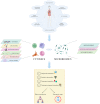Omics approaches open new horizons in major depressive disorder: from biomarkers to precision medicine
- PMID: 38938457
- PMCID: PMC11210496
- DOI: 10.3389/fpsyt.2024.1422939
Omics approaches open new horizons in major depressive disorder: from biomarkers to precision medicine
Abstract
Major depressive disorder (MDD) is a recurrent episodic mood disorder that represents the third leading cause of disability worldwide. In MDD, several factors can simultaneously contribute to its development, which complicates its diagnosis. According to practical guidelines, antidepressants are the first-line treatment for moderate to severe major depressive episodes. Traditional treatment strategies often follow a one-size-fits-all approach, resulting in suboptimal outcomes for many patients who fail to experience a response or recovery and develop the so-called "therapy-resistant depression". The high biological and clinical inter-variability within patients and the lack of robust biomarkers hinder the finding of specific therapeutic targets, contributing to the high treatment failure rates. In this frame, precision medicine, a paradigm that tailors medical interventions to individual characteristics, would help allocate the most adequate and effective treatment for each patient while minimizing its side effects. In particular, multi-omic studies may unveil the intricate interplays between genetic predispositions and exposure to environmental factors through the study of epigenomics, transcriptomics, proteomics, metabolomics, gut microbiomics, and immunomics. The integration of the flow of multi-omic information into molecular pathways may produce better outcomes than the current psychopharmacological approach, which targets singular molecular factors mainly related to the monoamine systems, disregarding the complex network of our organism. The concept of system biomedicine involves the integration and analysis of enormous datasets generated with different technologies, creating a "patient fingerprint", which defines the underlying biological mechanisms of every patient. This review, centered on precision medicine, explores the integration of multi-omic approaches as clinical tools for prediction in MDD at a single-patient level. It investigates how combining the existing technologies used for diagnostic, stratification, prognostic, and treatment-response biomarkers discovery with artificial intelligence can improve the assessment and treatment of MDD.
Keywords: antidepressant; biomarkers; major depressive disorder; precision medicine; system biomedicine.
Copyright © 2024 Stolfi, Abreu, Sinella, Nembrini, Centonze, Landra, Brasso, Cappellano, Rocca and Chiocchetti.
Conflict of interest statement
The authors declare that the research was conducted in the absence of any commercial or financial relationships that could be construed as a potential conflict of interest.
Figures



References
-
- World Health Organization . Global burden of mental disorders and the need for a comprehensive, coordinated response from health and social sectors at the country level - EB130/9. Geneva, Switzerland: Executive Board 130th Session; (2011).
-
- Global Burden of Disease Collaborative Network . Global Burden of Disease Study 2019 (GBD 2019) Results. Seattle, United States: Institute for Health Metrics and Evaluation (IHME; (2019).
Publication types
LinkOut - more resources
Full Text Sources

